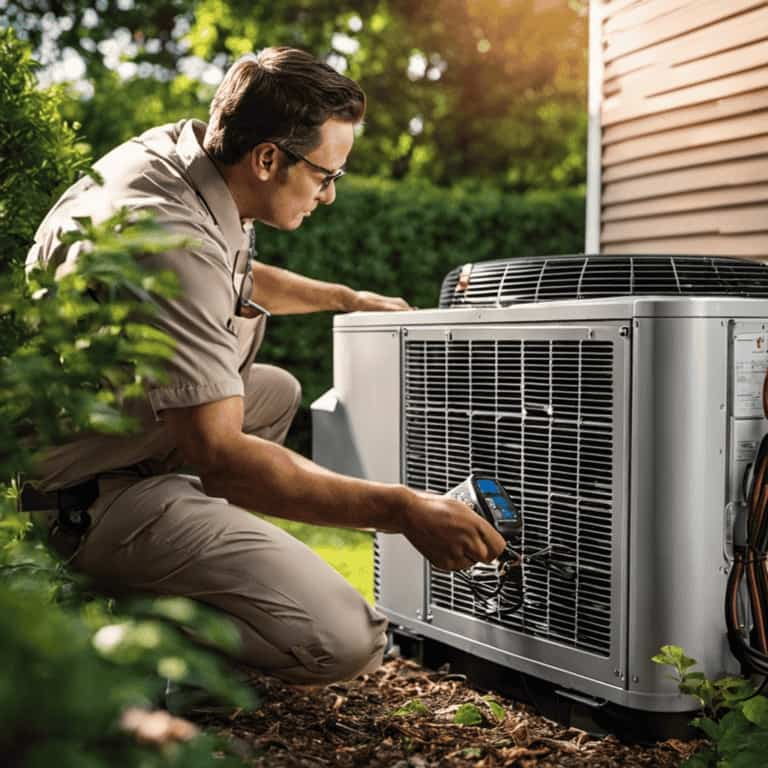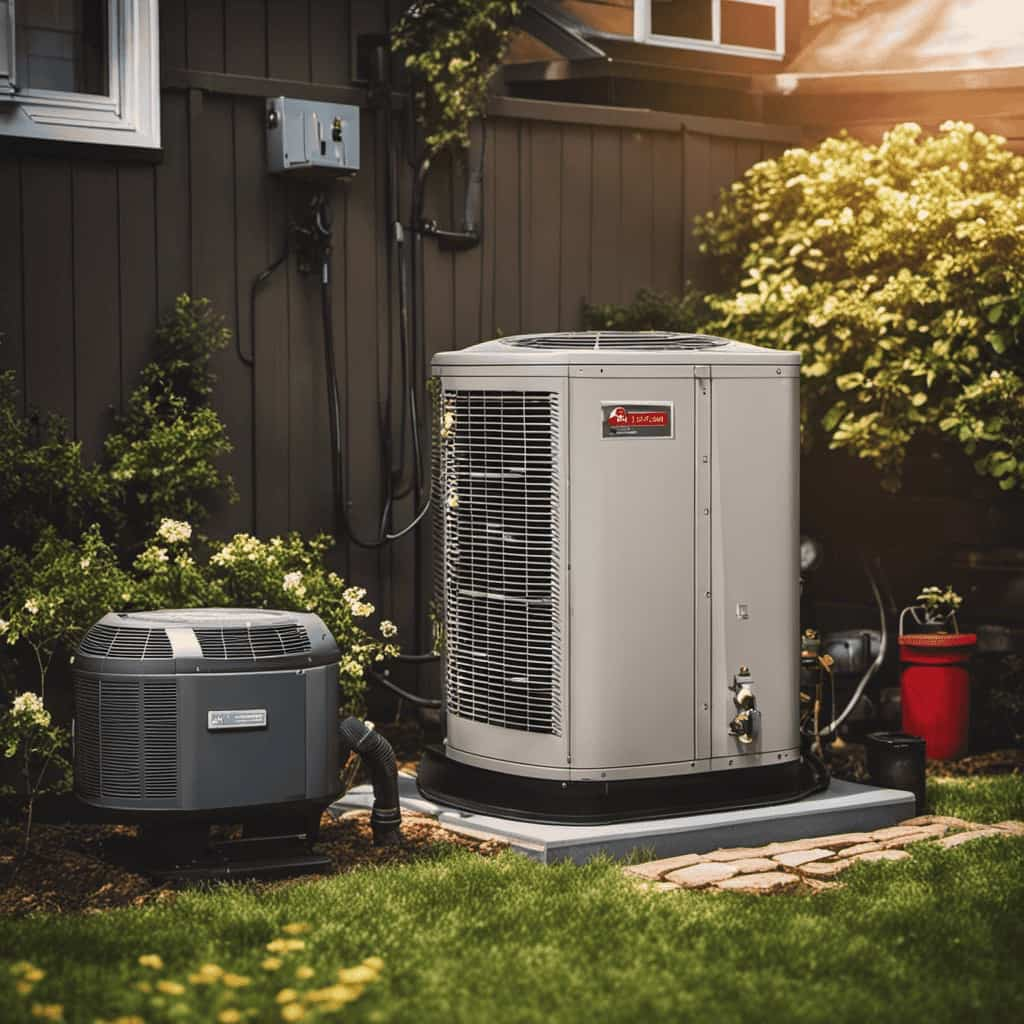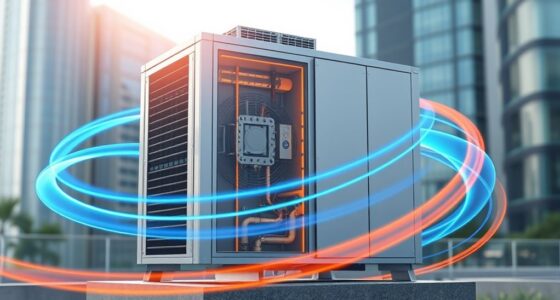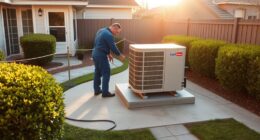Ever wondered how heat pumps efficiently transfer heat energy?
Well, we’ve got you covered with 11 key insights into this fascinating process.
From the basics of heat transfer modes to the role of refrigerants and the components that ensure efficiency, we’ll delve into it all.
Plus, we’ll explore challenges faced in high ambient temperatures and innovative solutions for next-generation heat pumps.

Get ready to dive deep into the world of thermal energy transfer in heat pumps!
Key Takeaways
- Heat pumps transfer thermal energy from a low-temperature source to a high-temperature sink.
- Understanding the different heat transfer modes (conduction, convection, and radiation) is crucial for optimizing heat pump performance.
- The choice of refrigerant in a heat pump system can impact its efficiency and environmental impact.
- The key components for efficient thermal energy transfer in a heat pump system include the evaporator coil, compressor, and condenser.
The Basics of Thermal Energy Transfer in Heat Pumps
We’ll now explore the basics of thermal energy transfer in heat pumps. Understanding heat pump operation is crucial for efficient performance and optimal energy transfer. Heat pumps work by transferring thermal energy from a low-temperature source to a high-temperature sink, using a refrigerant as the working fluid.
The refrigerant absorbs heat from the source, typically air, water, or the ground, and then releases it to the sink. Heat pump performance analysis involves evaluating key parameters such as coefficient of performance (COP), heating capacity, and efficiency.
COP measures the ratio of heat output to the energy input, indicating the efficiency of the heat pump. By analyzing the heat pump’s performance, we can identify areas for improvement and ensure that it operates at its highest potential, serving others effectively and efficiently.

Understanding Heat Transfer Modes in Heat Pump Systems
As we delve into the topic of heat transfer modes in heat pump systems, it’s important to understand the different ways in which thermal energy is transferred. Heat pump technology advancements have led to significant improvements in heat pump performance, making it crucial to grasp the mechanisms behind the transfer of thermal energy. In heat pump systems, there are three main modes of heat transfer: conduction, convection, and radiation.
Conduction is the transfer of thermal energy through direct contact between two substances. In a heat pump, this can occur when the refrigerant absorbs heat from the indoor air or the ground through the heat exchanger.
Convection, on the other hand, involves the movement of heat through a fluid, such as air or water. It plays a vital role in the heat pump cycle, facilitating the transfer of heat from the evaporator to the condenser.
Finally, radiation refers to the transfer of energy through electromagnetic waves. In heat pump systems, this mode of heat transfer is minimal but should still be considered.

Understanding the different heat transfer modes in heat pump systems is essential for optimizing heat pump performance and ensuring efficient operation. By comprehending how thermal energy is transferred, we can make informed decisions regarding system design and enhance overall energy efficiency.
With a solid foundation in heat transfer principles, we can now explore the role of refrigerants in thermal energy transfer.
The Role of Refrigerants in Thermal Energy Transfer
Refrigerants play a vital role in the transfer of thermal energy within a heat pump system, by facilitating the absorption and release of heat during the refrigeration cycle. The role of refrigerants in thermal energy transfer is closely tied to their thermal conductivity, which is a measure of how well a substance can conduct heat.
Refrigerants with high thermal conductivity are able to transfer heat more efficiently, resulting in better performance of the heat pump system. Additionally, the choice of refrigerant can impact the overall efficiency and environmental impact of the system.

It’s important to select a refrigerant that has a high heat transfer coefficient and low global warming potential, to ensure optimal performance and minimize environmental harm. The selection of the right refrigerant is crucial in ensuring that the heat pump system operates effectively and efficiently.
Key Components for Efficient Thermal Energy Transfer in Heat Pumps
One of the key components for efficient thermal energy transfer in heat pumps is the evaporator coil. This component plays a crucial role in the heat transfer process by allowing the refrigerant to absorb heat from the surrounding environment. To optimize circulation and improve conductivity, it is important to design the evaporator coil with the right specifications. This includes selecting the appropriate coil material, such as copper or aluminum, which have high thermal conductivity. Additionally, the design of the coil should promote efficient heat transfer by maximizing the surface area available for contact with the refrigerant. By optimizing circulation and improving conductivity, the evaporator coil ensures effective transfer of thermal energy in the heat pump system.
| Component | Function | Importance |
|---|---|---|
| Evaporator Coil | Absorbs heat from air | Crucial for efficient heat transfer |
| Compressor | Increases refrigerant pressure | Facilitates the movement of refrigerant through the system |
| Condenser | Releases heat to the environment | Essential for transferring heat from the refrigerant to the surroundings |
Efficient thermal energy transfer is vital for heat pump efficiency and overall system performance. By optimizing the key components, such as the evaporator coil, circulation can be enhanced, and conductivity can be improved. This leads to a more efficient heat transfer process, allowing the heat pump to effectively provide heating or cooling services. In the subsequent section, we will delve into the importance of heat pump efficiency and the significance of thermal energy transfer in achieving optimal performance.
Heat Pump Efficiency and the Importance of Thermal Energy Transfer
To achieve optimal heat pump efficiency, it’s crucial to understand and prioritize the importance of thermal energy transfer through the system. Heat pump performance is greatly influenced by the ability to transfer thermal energy effectively.

The efficiency of a heat pump is determined by its Coefficient of Performance (COP), which is the ratio of the heat output to the energy input. A higher COP indicates better energy efficiency.
The key to maximizing heat pump efficiency lies in minimizing energy losses during thermal energy transfer. This can be achieved by using well-insulated pipes, efficient heat exchangers, and proper refrigerant flow control.
Additionally, regular maintenance and proper sizing of the heat pump are essential to ensure optimal performance and energy efficiency.
Optimizing Heat Exchangers for Enhanced Thermal Energy Transfer
In order to enhance thermal energy transfer, we can optimize heat exchangers by using advanced designs and materials. Heat exchangers play a crucial role in the efficiency of heat pumps, as they facilitate the transfer of thermal energy between the working fluid and the surrounding environment. By optimizing heat exchangers, we can improve the overall performance and effectiveness of heat pump systems.

One method of optimizing heat exchangers is through the use of advanced designs. This involves designing the heat exchanger in a way that maximizes the surface area available for heat transfer. This can be achieved through the use of fins or microchannels, which increase the contact area between the working fluid and the surrounding medium.
Additionally, the choice of materials used in heat exchangers can greatly impact their performance. Materials with high thermal conductivity, such as copper or aluminum, can enhance heat transfer efficiency. Furthermore, materials with good corrosion resistance are essential to ensure the longevity and reliability of the heat exchanger.
The Impact of Insulation on Thermal Energy Transfer in Heat Pumps
While insulation is often overlooked, it plays a significant role in influencing the thermal energy transfer within heat pumps. Insulation helps to minimize heat loss and improve energy efficiency, leading to lower energy consumption and cost savings. Here are three key ways in which insulation impacts thermal energy transfer in heat pumps:
-
Reduced heat loss: Insulation acts as a barrier, preventing the escape of heat from the heat pump. This ensures that the thermal energy generated by the heat pump is retained within the system, maximizing its effectiveness.

-
Increased efficiency: By minimizing heat loss, insulation allows the heat pump to operate more efficiently. This means that less energy is wasted, resulting in higher overall energy efficiency and reduced environmental impact.
-
Enhanced performance: Proper insulation ensures that the heat pump functions optimally, delivering consistent heating or cooling. It helps to maintain the desired temperature by preventing external factors from affecting the system’s thermal energy transfer.
Exploring Heat Pump Cycling and Its Effect on Thermal Energy Transfer
Our research reveals that frequent heat pump cycling can have a significant impact on the efficiency of thermal energy transfer. Heat pump cycling refers to the process of the heat pump turning on and off to maintain the desired temperature in a space. Through heat pump cycling analysis, we’ve found that excessive cycling can lead to decreased energy transfer efficiency.
This is because each time the heat pump cycles on, it requires an initial burst of energy to start up, which can result in energy wastage. To optimize energy transfer, it’s important to minimize the frequency of heat pump cycling by properly sizing the heat pump to the heating or cooling load of the space. By doing so, we can ensure that thermal energy transfer is maximized, leading to improved energy efficiency.

With this understanding of heat pump cycling, let’s now explore the differences in thermal energy transfer between air-source and ground-source heat pumps.
Thermal Energy Transfer in Air-Source Vs. Ground-Source Heat Pumps
We have identified three key differences in thermal energy transfer between air-source and ground-source heat pumps:
-
Heat Source: Air-source heat pumps extract thermal energy from the surrounding air, while ground-source heat pumps extract thermal energy from the ground. This difference in heat source affects the efficiency and effectiveness of the heat pump.
-
Temperature Fluctuations: Air-source heat pumps are more susceptible to temperature fluctuations, as they rely on the air temperature for heat transfer. Ground-source heat pumps, on the other hand, benefit from the relatively stable temperature of the ground, resulting in more consistent and reliable thermal energy transfer.

-
Installation Complexity: Installing a ground-source heat pump involves burying a network of pipes in the ground, which requires excavation and additional labor. Air-source heat pumps, on the other hand, are easier to install since they don’t require extensive ground work.
Understanding these differences is crucial for homeowners and HVAC professionals when deciding between air-source and ground-source heat pumps, as it can significantly impact the performance and efficiency of the system.
Overcoming Challenges in Thermal Energy Transfer for High Ambient Temperatures
To effectively overcome challenges in thermal energy transfer for high ambient temperatures, we must adapt the design and materials used in heat pumps. Overcoming limitations in this area requires advancements in technology that can handle the demands of extreme temperatures. One approach is to improve the efficiency of heat exchangers by using materials with higher thermal conductivity and corrosion resistance. Another solution is to optimize the refrigerant cycle to enhance heat transfer and reduce energy consumption. Additionally, incorporating variable speed compressors and fans can provide better control over the system’s performance, allowing for more efficient operation in high ambient temperature conditions. By implementing these advancements, heat pumps can effectively transfer thermal energy even in the most challenging environments.
| Challenge | Solution | Benefits |
|---|---|---|
| High ambient temperatures | Materials with higher thermal conductivity and corrosion resistance | Improved efficiency and durability |
| Energy consumption | Optimized refrigerant cycle | Enhanced heat transfer and reduced energy usage |
| Performance control | Variable speed compressors and fans | Greater system control and efficiency |
These advancements in technology enable heat pumps to overcome limitations in thermal energy transfer for high ambient temperatures, ensuring reliable heating and cooling even in extreme conditions. Now, let’s explore the innovations in thermal energy transfer for next-generation heat pumps.

Innovations in Thermal Energy Transfer for Next-Generation Heat Pumps
As we explore innovations in thermal energy transfer for next-generation heat pumps, one key aspect to consider is enhanced heat pump efficiency.
Improving the efficiency of heat pumps is crucial for maximizing thermal energy transfer and reducing energy consumption.
By utilizing advanced technologies and design modifications, such as optimized compressor systems and intelligent control algorithms, next-generation heat pumps can achieve higher efficiency levels.
This results in more sustainable heating solutions for various applications.

Enhanced Heat Pump Efficiency
By implementing new innovations in thermal energy transfer, we can enhance the efficiency of next-generation heat pumps. These advancements are crucial in improving energy efficiency and maximizing heat pump performance.
Here are three key innovations that can contribute to enhanced heat pump efficiency:
-
Advanced Heat Exchangers: Utilizing advanced materials and designs for heat exchangers can optimize heat transfer and minimize energy loss. Enhanced heat exchangers can improve the overall performance of the heat pump system.
-
Variable Speed Compressors: By incorporating variable speed compressors, heat pumps can adjust their operation based on the heating or cooling demands of the space. This flexibility allows for more precise temperature control and reduces energy consumption.

-
Smart Controls and Sensors: Integrating smart controls and sensors into heat pump systems enables better monitoring and optimization of energy usage. These technologies can automatically adjust settings based on occupancy and weather conditions, maximizing efficiency and reducing energy waste.
Implementing these innovations in thermal energy transfer will result in more efficient next-generation heat pumps, providing improved comfort while reducing energy consumption and costs for the end-users.
Sustainable Heating Solutions
In our quest for sustainable heating solutions, we aim to explore innovations in thermal energy transfer for next-generation heat pumps that can revolutionize the way we heat our homes and buildings.
Sustainable heating technologies have become increasingly important as we seek renewable energy solutions to reduce our carbon footprint and mitigate climate change. These technologies harness natural and renewable sources of energy, such as geothermal heat, solar energy, and even waste heat from industrial processes.

By utilizing these renewable energy sources, next-generation heat pumps can provide efficient and environmentally-friendly heating solutions. Innovations in thermal energy transfer, such as advanced heat exchangers and improved refrigerants, allow for greater heat transfer efficiency, resulting in enhanced performance and reduced energy consumption.
These advancements in sustainable heating technologies have the potential to significantly reduce our reliance on fossil fuels and pave the way for a cleaner and greener future.
Frequently Asked Questions
How Does the Size of a Heat Pump Affect Thermal Energy Transfer?
The size of a heat pump directly affects thermal energy transfer. A larger heat pump can transfer more heat, resulting in increased efficiency. However, it is important to consider the specific needs and requirements of the system to determine the optimal size.
What Are Some Common Problems That Can Hinder Thermal Energy Transfer in Heat Pumps?
Common problems that hinder thermal energy transfer in heat pumps are dirty filters, refrigerant leaks, and low refrigerant levels. Common solutions include cleaning or replacing filters, repairing leaks, and recharging refrigerant. Troubleshooting techniques can help identify and address these issues.

Are There Any Regulations or Standards in Place Regarding Thermal Energy Transfer in Heat Pumps?
Yes, there are regulations and standards in place regarding thermal energy transfer in heat pumps. These guidelines ensure efficient and safe operation, promote energy conservation, and protect the environment. Compliance with these regulations is essential for optimal performance.
Can the Type of Refrigerant Used in a Heat Pump Impact Its Thermal Energy Transfer Efficiency?
Oh boy, let’s talk about the impact of refrigerant on thermal energy transfer efficiency in heat pumps. We’ll analyze the environmental factors, compare different refrigerants, and get all technical and detailed for you. Can’t wait!
Are There Any Advancements or Emerging Technologies Being Developed to Improve Thermal Energy Transfer in Heat Pumps?
Advancements and emerging technologies are being developed to improve thermal energy transfer in heat pumps. These innovations aim to enhance efficiency, reduce energy consumption, and increase overall performance, leading to a more sustainable and cost-effective heating and cooling solution.
Conclusion
In conclusion, the insights discussed in this article provide a comprehensive understanding of thermal energy transfer in heat pumps. By examining the basics, heat transfer modes, refrigerants, key components, efficiency, cycling, and challenges, we’ve gained valuable knowledge.

Additionally, we explored the differences between air-source and ground-source heat pumps and discussed innovations for future advancements. With these insights, we can confidently say that heat pumps are a remarkable technology, capable of transferring thermal energy with astonishing efficiency and effectiveness.









